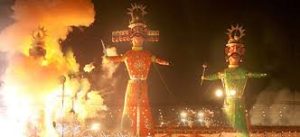 One of the famous festivals celebrated in India, Dussehra is celebrated on the 10th day of the Hindu autumn lunar month of Ashvin, which is between September and October according to the western calendar.
One of the famous festivals celebrated in India, Dussehra is celebrated on the 10th day of the Hindu autumn lunar month of Ashvin, which is between September and October according to the western calendar.
It is also celebrated on a large scale in Bangladesh and Nepal and is famously known as ‘Vijayadashmi’. In Nepal, it is the largest festival and this day culminates the ten day Navratri. Not only do Hindus celebrate it with great zeal and enthusiasm but also it is quite famous amongst Non-Hindus as well.
This day marks the beginning of the harvest season in India and the ‘mother earth’ is invoked to reactivate the vigor and fertility in the soil. All this is done by performing rituals and religious activities on the day of Vijayadashmi. It is believed that the rituals and customs invoke cosmic forces that lead to the rejuvenation of the soil.
Whereas in Bangladesh, Dussehra is a five day long celebration and great ‘mandaps’ or congregations are setup for these special days. Amongst all the celebrations of Dussehra, the largest one takes place in Dhaka at the Dhakeshwari temple. On the final day of Dasha-hara (dussehra) large clay idols of goddess Durga are submerged in rivers (running water). Turmeric is widely used for performing the rituals.
Meaning of Dussehra
Famously known as Dasha-hara, Dassera and Durgotsav, this festival has its own unique meaning. This is a festival which marks the victory of good over the evil. The word ‘Dussehra’ is made up of two Hindi words, ‘Dus‘ and ‘Hara‘, where ‘Dus’ means ten and ‘Hara’ annihilated. So if these two words are combined, ‘Dussehra’ stands for the day when the ten evil faces (the ten faced Ravana) were destroyed (by Lord Rama).
Dussehra is celebrated in different parts of the country and the world for the same basic reason. Dussehra or Vijayadashmi signifies the victory of the good over the evil.
Facts about Dussehra
- Not many know that Dussehra is also celebrated as the Vishwakarma Divas, which is the National Labour Day of India.
- Vijayadashmi is a day when weapons are worshipped which is famously known as the ‘Shastra Puja‘. This draws it significance from two sources, one being the epic Mahabharata and the other being the worship of the weapons used by Goddess Durga to kill Mahishasur.
- Another fact about this day is the Vyasa Puja, which is the worship of the foremost Guru, Guru Veda Vyasa.
FAQ’s about Dussehra
What is Dussehra?
Dussehra is a festival celebrated in Hinduism which marks the victory of good over evil.
What is Ganga Dussehra?
Ganga Dussehra celebrates the descent of the holy river Ganga to the Earth. It is celebrated for the first 10 days of the month of Jyeshtha (June in western calendar) and devotees worship the holy river and take a dip in it.
Why do we celebrate Dussehra?
Dussehra marks the victory of good over evil. It originated from the Ramayana where Lord Rama kills the evil Ravana and wins his wife back from the demon’s custody.
Which are the places in India famous for Dussehra?
Though Dusshera is widely celebrated its celebrations are grand and famous in western Uttar Pradesh, Mysore, Karnataka, Orissa and Andhra Pradesh.
What are the main attractions of Dussehra?
The main attraction of Dussehra is the ‘Ramlila’ which is the public staging of the ‘katha’ (story) Ramayana which starts a number of days before so that the killing of Ravana takes place at this very day. Also with the ‘Katha’ going on there rides and stalls for the masses to enjoy.
What are the other names of Dussehra?
Dussehra is famously known as ‘Vijayadashmi’. Also it is known as Dash-hara, Dassera and Dashain.
How did Dussehra originate?
The festival of Dussehra draws its origination from two sources, the basic theme being the same, which is the victory of Good over Evil. Lord Rama killed the ten headed evil Ravana and so good won over evil and hence Dussehra. Also Goddess Durga killed Mahishasur, which again marks the victory of a good over evil.





